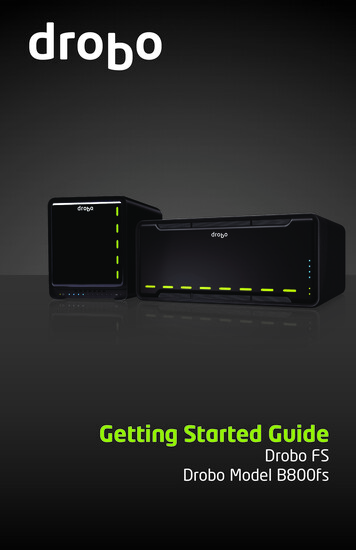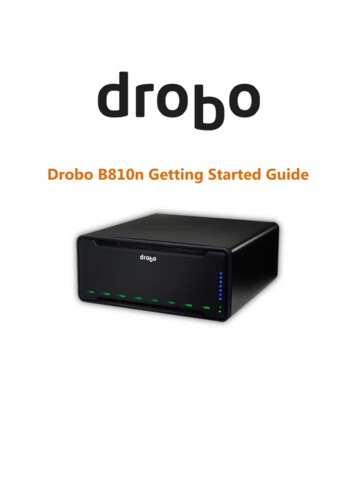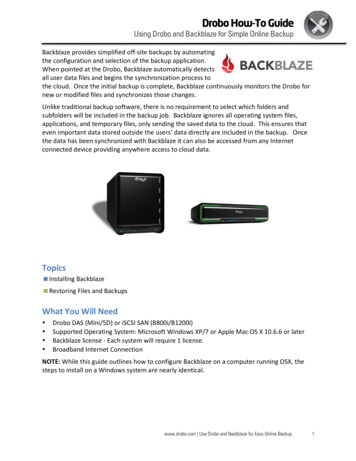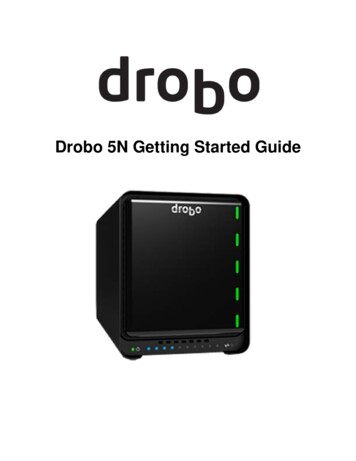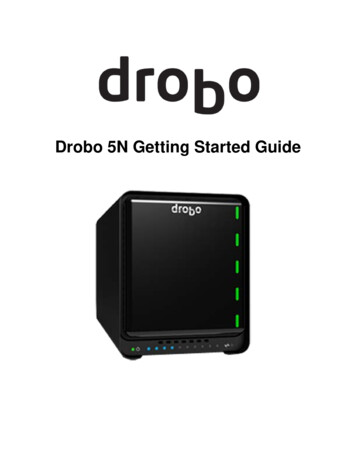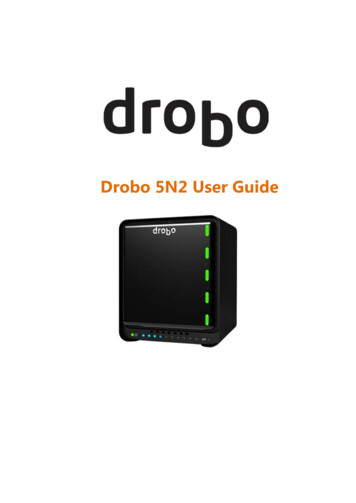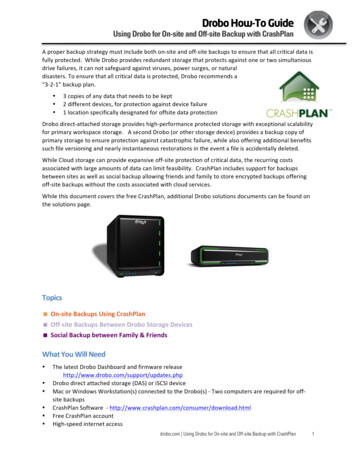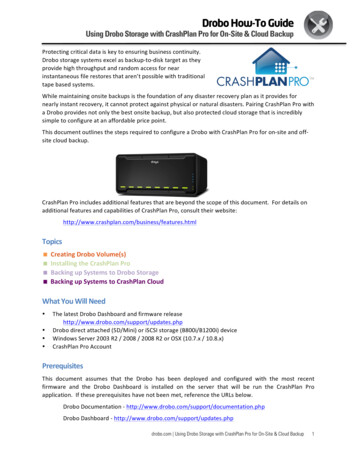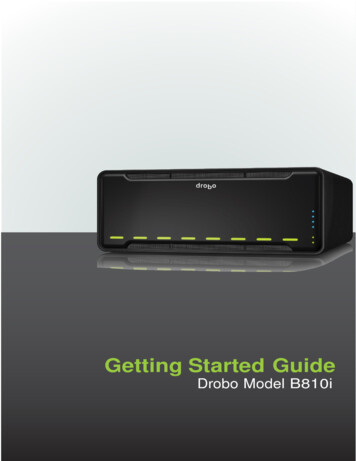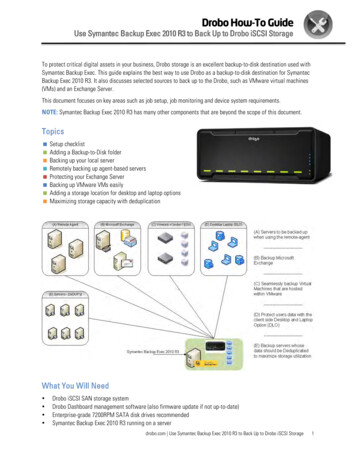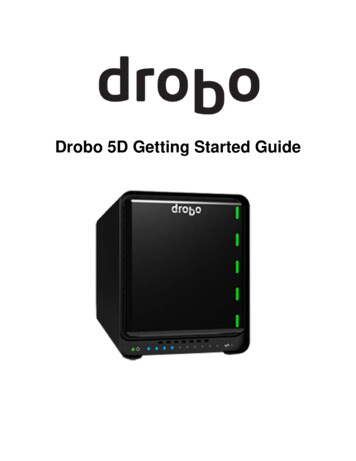
Transcription
Drobo 5D Getting Started Guide
Table of ContentsBefore You Begin . 3Product Features at a Glance . 3Checking Box Contents . 4Checking System Requirements . 5Operating Systems Supported . 5Connectivity Interfaces Supported for the Drobo 5D . 5Checking the Hardware You Need . 8Selecting Drives . 8Determining Drive Space Requirements. 10Using Power Protection. 10Setting Up Your Drobo 5D. 11Installing Drobo Dashboard . 11Installing an mSATA SSD . 16Inserting the Drives . 17Connecting Cables on Your Drobo 5D . 18Connecting Directly to Your Drobo 5D . 18Daisy-chaining with Your Drobo 5D . 19Formatting the Drives . 22Selecting a File System and Volume Size for Your Drobo 5D . 22Turning On Your Drobo 5D and Formatting the Drives . 23Where to Go Next. 28Using Best Practices . 28Keeping Your Software Up to Date . 28Checking for Software Updates Automatically . 28Checking for Software Updates Now . 30Manually Updating Firmware from the Website . 30Safely Shutting Down Your Drobo 5D . 31Safely Shutting Down Your Drobo 5D Using Drobo Dashboard . 32Safely Shutting Down Your Drobo 5D Manually . 34Using the Online User Guide . 34Using Context-Sensitive Help . 34Using the Knowledge Base . 35Registering Your Drobo 5D . 35Getting Support . 38Copyright, Safety and Limited Warranty . 39Drobo 5D Getting Started Guide2
Before You BeginBefore you begin setting up your Drobo 5D, it’s a good idea to check system and hardwarerequirements.This section covers the following topics:Product Features at a GlanceChecking Box ContentsChecking System RequirementsChecking the Hardware You NeedProduct Features at a GlanceFor a quick overview of features of the Drobo 5D, refer to the following images.Figure 1: Front of the Drobo 5D with the bezel (faceplate) removed.Drobo 5D Getting Started Guide3
Figure 2: Back of the Drobo 5D.Checking Box ContentsCheck your product's box to ensure it contains all the components in the list below. Drobo 5D 2 m (6.6 ft) USB 3.0 cable 1.8 m (6.6 ft) power cord with power supply Quick Start Card Safety and Warranty GuideDrobo 5D Getting Started Guide4
Checking System RequirementsCheck to ensure your operating system and cable interface are supported.This section covers the following topics:Operating Systems SupportedConnectivity Interfaces Supported for the Drobo 5DOperating Systems SupportedOperating systems supported for the Drobo 5D are as follows. OS X 10.7.x Lion OS X 10.8.x Mountain Lion Windows 7 (Service Pack 1 or later, 32-bit and 64-bit) Windows 8 (32-bit and 64-bit)Notes:-For best performance and interoperability, ensure you are running the latest service packs forthe appropriate Windows operating systems.-For the most current list of supported operating systems, check the specifications for yourproducts online at www.drobo.com/products/index.php.Connectivity Interfaces Supported for the Drobo 5DYour Drobo 5D connects directly to your computer using one of the following connectivity ports.We recommend that you use the fastest connection you have available on your computer.Notes:-You can only use one connection at a time.-If you would like to use the USB 3.0 interface and it is not available on your computer, youcan purchase and install an add-on adapter card. (This is a circuit board that fits into anexpansion slot in your computer and provides the interface you want.)ThunderboltDeveloped by Intel with collaboration from Apple, Thunderbolt is a flexible, high-performanceinterface that provides a high-speed connection to peripheral devices from a computer. It has theability to combine data, video, audio and power all in a single connection, concurrently. EachThunderbolt connector can provide two full-duplex channels, with each channel providing 10Gbps of bi-directional bandwidth, meaning it can transmit and receive data at the same time.Drobo 5D Getting Started Guide5
The Drobo 5D has two Thunderbolt ports, enabling you to take advantage of Thunderbolt's daisychaining capabilities. With Thunderbolt, you can daisy-chain up to six peripheral devices and onedisplay from a single computer. Note that because Thunderbolt has dual-protocol support (withDisplayPort and PCI Express), you can connect your computer to Thunderbolt devices orDisplayPort products. You can also connect non-Thunderbolt devices at the end of a daisy-chainby using Thunderbolt technology adapters.Here are three options for connecting your Drobo device using its Thunderbolt interface.1. Your Drobo device directly connected to a computer (with no daisy-chain).Drobo 5D Getting Started Guide6
2. Multiple Drobo devices connected in a chain with a DisplayPort monitor at the end.3. Your Drobo device connected to an external Thunderbolt monitor that is then connected to acomputer (with the Drobo device at the end).Drobo 5D Getting Started Guide7
USB 3.0USB (Universal Serial Bus) is a popular interface that allows you to attach additional hardwaredevices to your computer in a plug-and-play style. USB 3.0, also known as SuperSpeed USB,provides data transfer speeds of up to 4.8 Gbit/s, much faster than USB 2.0.In order to take advantage of this technology, your Drobo 5D must be connected to a USB 3.0port on your computer. If your computer does not have USB 3.0, you can consult with yourcomputer manufacturer to find a compatible USB 3.0 card.Note: If your computer only has a USB 2.0 connection, then Drobo 5D will auto-negotiate to USB2.0 speeds.Checking the Hardware You NeedTo use your Drobo 5D, you will need at least two drives. If you plan to use Dual DiskRedundancy, which protects your data against two drive failures, you will need at least threedrives.This section covers the following topics:Selecting DrivesDetermining Drive Space RequirementsUsing Power ProtectionSelecting DrivesThe Drobo 5D supports both standard 3.5” SATA hard disk drives (HDDs) as well as SATA solidstate drives (SSDs) for added performance. For HDDs, these drives can be from anymanufacturer and with any capacity. For SSDs, please visit our web page for compatible driveoptions.In addition, the Drobo 5D has a Drobo Accelerator Bay, which accepts an industry-standardmSATA SSD(Solid State Drive). When the mSATA SSD is installed, Drobo’s Data-Aware Tieringfeature is enabled, accelerating performance when reading data from your Drobo device. Havingan mSATA SSD installed leaves all drive bays available for high-capacity hard disk drives (HDDs)so that you can get both high-capacity and accelerated performance out of your Drobo device.Using only SSDs in the main drive bays of your Drobo 5D provides the fastest performance whenreading and writing data to and from your Drobo device.In summary, here are the recommended number and type of drives you can use with yourDrobo 5D. Note that you need at least two drives in the drive bays to ensure your data isprotected in the event of drive failure. 2 to 5 HDD(Hard Disk Drive)s in the main drive bays - enables you to maximize capacity 2 to 5 HDDs in the main drive bays plus an mSATA SSD installed - enables you tomaximize capacity and accelerate read performance 2 to 5 SSD(Solid State Drive)s in the main drive bays with no mSATA SSD - enables youto maximize read and write performanceFor a performance comparison of these options, see the following illustration.Drobo 5D Getting Started Guide8
Important Notes:-If an incompatible SSD is inserted into the Drobo device, the drive light will blink red,indicating the need to replace that drive. Please refer to our web page on compatible driveoptions. for more information.-The mSATA SSD card is not part of the disk pack of your Drobo 5D, allowing you to leave itinstalled even if you transfer drives from the drive bays to another Drobo device, for example.-When Data-Aware Tiering is enabled, an icon displays in Drobo Dashboard, the softwarecompanion to your Drobo device.-The Drobo 5D is not compatible with IDE(Integrated Drive Electronics), SCSI(SmallComputer System Interface), PATA(Parallel Advanced Technology Attachment) orSAS(Serial Attached SCSI) drives.Warning! Any pre-existing data on the drives will be erased when inserted into the Drobo 5D.Drobo 5D Getting Started Guide9
Determining Drive Space RequirementsIn order to protect your data from drive failure, your Drobo 5D requires more space than what youwill use for your data, sometimes as much as double or more the amount of space.The best way to determine how much usable, protected storage space you will have available foryour data, based on the number and capacity of your drives, is to use our Capacity Calculator atwww.drobo.com/calculator.A shortcut to estimating the capacity available for your data is to omit the largest drive and thenadd the capacity of the remaining drives. If you plan to use Dual Disk Redundancy, omit thelargest two drives. For example:Single Disk (Default) RedundancyDual Disk RedundancyNotes:-Actual capacity is often less than what is shown in the examples above due to the differentsystems used for rating capacity. This has nothing to do with Drobo devices.-Know that all Drobo devices enable you to easily increase storage capacity at any time bysimply inserting additional drives or replacing smaller drives with larger ones.Using Power ProtectionWe recommend using the following power protection with your Drobo device: An uninterruptible power supply (UPS), which protects against sudden losses in power A power surge protector to protect against power surgesDrobo 5D Getting Started Guide10
Setting Up Your Drobo 5DOnce you have unpacked your Drobo 5D from its box and ensured you meet all system andhardware requirements, it is time to set up your Drobo 5D for use. This can be done in just a feweasy steps!1. Install Drobo Dashboard.2. Install an mSATA Card (optional).3. Insert the drives.4. Connect the cables.5. Turn on the power and format the drives.Installing Drobo DashboardDrobo Dashboard is the software companion to your Drobo 5D, enabling you to easily set up andmanage your Drobo device. Immediately following installation, you can choose to set DroboDashboard to automatically install version updates, which we highly recommend.Drobo software and firmware updates can also be installed fromwww.drobo.com/support/updates.Note: You need to have administrator rights on the computer on which you install DroboDashboard, and also have access to the Internet.1. Navigate to www.drobo.com/start and click on the latest Drobo Dashboard for your Droboproduct to run and install it.Note: The first time you install Drobo Dashboard, you will be asked to select a language fromthe drop-down list. Please do this.The Drobo Dashboard Installer (or Installation Wizard) opens, preparing to install.Drobo 5D Getting Started Guide11
On a Mac, this screen appears as follows.In Windows, this screen appears as follows.Drobo 5D Getting Started Guide12
2. Click the Next (Windows) or Continue button (Mac), as appropriate.Note: If the Microsoft iSCSI Initiator window appears, click the Yes button. Follow theinstructions to install the Microsoft iSCSI Initiator, clicking the Next button as needed. Whenfinished, you are returned to the InstallShield Wizard to continue installation.3. Follow the directions of the Installation Wizard, clicking the Next or Continue button aftereach page, as appropriate.4. When you reach the installation page, click the Install button.On a Mac, this screen appears as follows.Drobo 5D Getting Started Guide13
In Windows, this screen appears as follows.Depending on your operating system, one of the following may result: On a Mac, you will be prompted for your administrator password. Enter it and click theappropriate button. In some Windows operating systems, a Windows Access Control dialog box appears,asking if you want to allow changes to your computer. Click the Allow or Yes button, asappropriate.Drobo Dashboard installs on your computer.5. If you are on a Mac, you will be prompted to restart your computer in order to completeinstallation. Do this.6. After installation is complete, leave the Launch Drobo Dashboard check box selected andclick the Finish button.Note: Before Drobo Dashboard launches, you may be asked if Drobo can collect anonymousinformation on your usage. Click Yes or No, as desired. You may also be prompted toregister your Drobo device now.The Drobo Dashboard application launches and the All Drobos page opens. After a fewseconds, Drobo "discovers" all Drobo devices currently connected and displays them on thispage.If you have no Drobo devices yet connected or powered on, a "No Drobos Detected"message displays until you do.Drobo 5D Getting Started Guide14
Drobo 5D Getting Started Guide15
Installing an mSATA SSDYou can install an mSATA SSD into your Drobo 5D. Doing so provides accelerated performancewhen reading data from your Drobo 5D. For more information on drive requirements, seeSelecting Drives.It is best to install the mSATA SSD before inserting drives into the Drobo 5D's drive bays.Important Notes:- The mSATA SSD is not part of your Drobo device's disk pack, so you can add or remove it atany time.-Your Drobo device must be powered off and unplugged before installation.- It is important to ground yourself before installing the mSATA SSD in order to dischargestatic electricity. To do so, touch a grounded metal object just before installation.Warning! If there is any pre-existing data on the mSATA SSD it will be erased. If you wish tokeep the data, copy it to another drive or medium before using with your Drobo device.1.Gently turn the Drobo 5D on to its side to access the bottom of the Drobo 5D, and open theDrobo Accelerator Bay door by turning the latch from lock to unlock using a coin.2. Slide the mSATA SSD into the slot as depicted in the image below.3. Make sure the mSATA SSD is aligned properly with its connector, and then close the DroboAccelerator Bay door, turn the latch back to the lock icon, and return the Drobo 5D to itsnormal position.Drobo 5D Getting Started Guide16
Inserting the DrivesAfter installing Drobo Dashboard and, if needed, installing an mSATA SSD, you are ready toinsert drives into your Drobo 5D. For more information on drive requirements, see SelectingDrives.Warning! Any pre-existing data on the drives will be erased, as the drives will be formatted. If youwish to keep the data, copy it to another drive or medium before using with your Drobo device.Note: Once you insert the drives into your Drobo device, they function as a unit or “pack.” Toaccess the data on them, you will need the entire pack.1. Remove the front bezel (faceplate) from the front of your Drobo device by pulling it off.2. With one hand, hold the drive so that the label on the top of the drive faces up (and itsconnectors are positioned at the device and toward the left). Refer to one of the imagesbelow, depending on whether your Drobo device is vertical or horizontal.3. With your other hand, use your thumb to depress and hold open one of the drive locks to aselected drive bay. Refer to the image below.4. Slide the drive into the drive bay, release the drive lock and push the drive into place until youfeel it connect.The drive lock snaps behind the drive, securing it into place.Note: If you are inserting an SSD (Solid State Drive), ensure that it is compatible by visitingour web page on compatible drive options.5. Insert additional drives in the same manner, following steps 2 through 4.6. When finished, replace the faceplate right side up, so that when your Drobo device is turnedon, you will be able to see the indicator lights.You are now ready to connect cables and power on your Drobo device.Drobo 5D Getting Started Guide17
Connecting Cables on Your Drobo 5DAfter installing Drobo Dashboard and inserting the drives into your Drobo 5D, you are ready toconnect the power and data cables on your Drobo device. There are two ways you can connectthe data cables: You can connect the Drobo 5D directly to your computer using the Thunderbolt port USBor the 3.0 port. For information on the different connectivity interfaces available and theirrequirements, see Connectivity Interfaces Supported for the Drobo 5D. If you use the Thunderbolt port, you also have the option to connect the Drobo 5D toanother Thunderbolt-enabled device that is attached to your computer (including anotherDrobo device or a display monitor) in a daisy-chain manner. The Drobo 5D can be thefirst in the daisy-chain (directly attached to your computer), in the middle, or at the end.For more information and steps, see Connecting Your Drobo 5D in a Daisy-chain.Connecting Directly to Your Drobo 5DYou can connect the Drobo 5D directly to your computer using the Thunderbolt port or the USB3.0 port. For information on the different connectivity interfaces available and their requirements,see Connectivity Interfaces Supported for the Drobo 5D.If you are using a Thunderbolt port and would like to connect the Drobo 5D in a daisy-chain, seeConnecting Your Drobo 5D in a Daisy-chain.As you follow the steps below, refer to the following image.1.Plug one end of the USB or the Thunderbolt cable into the back of your Drobo 5D.2. Plug the other end of the cable into your host computer.3.Connect the power supply to the power connection at the back of your Drobo device.4.Connect the other end of the power supply to a power source.Note: We recommend plugging into an uninterruptible power supply (UPS) or surgeprotector. For more information, see Using Power Protection.You are now ready to turn on your Drobo device and format the drives.Drobo 5D Getting Started Guide18
Daisy-chaining with Your Drobo 5DWith the Thunderbolt port, you can connect the Drobo 5D directly to your computer or to anotherThunderbolt-enabled device in a daisy-chain manner. The Drobo 5D performs best when it is thefirst in the daisy-chain, but it can also be in the middle or at the end.You can daisy-chain up to six peripheral devices and one display (which can be a DisplayPortmonitor) from a single computer. The non-Thunderbolt display needs to be at the end of thechain.Note: As long as they are plugged in, Drobo devices do not need to be powered on forThunderbolt interfaces to remain active. This enables other devices in the chain to remainaccessible by the computer.Here are three options for connecting your Drobo device using its Thunderbolt interface.1. Your Drobo device directly connected to a computer (with no daisy-chain).Drobo 5D Getting Started Guide19
2. Multiple Drobo devices connected in a chain with a DisplayPort monitor at the end.3. Your Drobo device connected to an external Thunderbolt monitor that is then connected to acomputer (with the Drobo device at the end).Drobo 5D Getting Started Guide20
As you follow the steps below, refer to the following image.1. Plug one end of the Thunderbolt cable into the back of your Drobo 5D.2. Do one of the following: Plug the other end of the cable into your host computer, so that the Drobo 5D is the firstperipheral in the daisy-chain. Be sure to connect the next Thunderbolt-enabled peripheralor non-Thunderbolt display monitor to the second port on your Drobo 5D, as needed toextend the chain. Plug the other end of your cable into another Thunderbolt-enabled device that isattached to your host computer. You can optionally connect another Thunderbolt-enabledperipheral or non-Thunderbolt display monitor to the second port on your Drobo 5D, asneeded to extend the chain.3. Connect the power supply to the power connection at the back of your Drobo device.4.Connect the other end of the power supply to a power source.Note: We recommend plugging into an uninterruptible power supply (UPS) or surgeprotector. For more information, see Using Power Protection.You are now ready to turn on your Drobo device and format the drives.Drobo 5D Getting Started Guide21
Formatting the DrivesAfter installing Drobo Dashboard, inserting the drives into your Drobo 5D and connecting cables,you are ready to turn on your Drobo device and format the drives.Before following steps for this, however, it is important to know what file system format andvolume size you will choose when you format the drives.Selecting a File System and Volume Size for Your Drobo 5DWhen you turn on your Drobo 5D, you will be prompted to format the drives in your Drobo 5D witha particular file system. What file system formats are available to you depend on your operatingsystem. (See Figure 1 below.)You will also be formatting your Drobo 5D into at least one volume, and you will need to choose asize for that volume. A volume is a storage area that has been formatted with a file system formatyour operating system can recognize. In Windows, volumes are sometimes called “logical drives”or “partitions.”The largest volume size you are allowed depends on the file system format you choose and thetotal capacity of the drives in your Drobo device. The following table (Figure 1) shows themaximum volume size allowed for each file system format.Figure 1: Table of file system formats and maximum volume sizesImportant Notes:-Volume size does not represent how much actual storage space is available on your Drobo5D. It represents virtual storage space. For example, your Drobo 5D may be loaded with 2TBof drive space, but you can create a volume of 16TB. What this enables you to do is addmore capacity to your Drobo 5D (by inserting an additional drive or replacing a smallercapacity drive with a larger capacity one) without having to format an additional volume. Theadditional capacity becomes part of the same volume you formatted originally.-Your operating system may show the virtual space you have available on your Drobo device,as defined by the volume size.-If the amount of available, protected storage space in your Drobo 5D ever exceeds the sizeof the volume that you chose (this may occur when you add one or more additional drives toyour Drobo 5D), then Drobo Dashboard will automatically create a new volume (or volumes)of the same size as the original volume. Drobo Dashboard will notify you when this occursand ask you to format and name the new volume(s).Tip: For most customers, we recommend choosing the largest volume size available for theselected file system. Note, however, that smaller volume sizes can be more efficient andmanageable in certain situations, such as when indexing, scanning or searching volumes.Drobo 5D Getting Started Guide22
Turning On Your Drobo 5D and Formatting the DrivesWith Drobo Dashboard installed on your host computer and cables connected, you are ready toturn on your Drobo device and format the drives.1. With Drobo Dashboard open on your computer, press the power toggle button on the back ofyour Drobo device once.Your Drobo device powers on and appears on the All Drobos page in Drobo Dashboard.Note: Some Windows and Mac operating systems will also prompt you to format the drives.Click Cancel or Ignore, as appropriate, and continue with formatting from Drobo Dashboard.2.Double-click on the Drobo 5D icon on the All Drobos page.A message appears, asking if you would like to format the device.3.Click the Yes button.The Format Type page opens. Depending on your operating system the page displays withdifferent options.The File Format page for Drobo 5D in OS X:Drobo 5D Getting Started Guide23
The File Format page for Drobo 5D in Windows:4. Select the appropriate file format for your operating system and click the Next button.Drobo 5D Getting Started Guide24
The Volume Size page opens.5. Click and drag to slide the pointer to the size of the volume you would like to create, and thenclick the Next button.Tip: We recommend that you select the largest size available, enabling you to increase thenumber and capacity of your drives without having to format an additional volume.Drobo 5D Getting Started Guide25
The Volume Name page opens.6. If applicable, from the Drive Letter drop-down list, select the drive letter to assign to thevolume.7. In the Name text box, modify the default name for the volume as you like.Tip: We recommend using the word “volume” in the name so as not to confuse the volumename with your Drobo device’s name.8. Click the Next button.The Confirm Format page opens.9.Click the Format button.A message appears, informing you that it can take up to five minutes to format your drives,and that this may require rebooting your Drobo device. Afterwards, the Format dialog boxopens.Drobo 5D Getting Started Guide26
10. Click the OK button.Your Drobo device displays on the Status page of Drobo Dashboard, as follows.Note: Drobo Dashboard automatically assigns “Drobo” as the default name for your Drobodevice, which you can rename later.Drobo 5D Getting Started Guide27
Where to Go NextAfter you’ve set up your Drobo 5D, you’re ready to store and back up data onto it. Next stepsinclude the following. Click on a topic to learn more. Implementing best practices to maximize the safety of your data Ensuring optimal performance by keeping your software (Drobo Dashboard and yourDrobo device’s firmware) up to date Knowing how to safely shut down your Drobo device Using the Online User Guide and context-sensitive help to learn more about how tomanage and use your Drobo device Using our knowledge base to answer almost any additional question Registering your Drobo 5D Getting the support you may needUsing Best PracticesAlthough your Drobo 5D provides redundancy and automatically protects your data against adrive failure, it should only be one part of an overall, digital asset management strategy.To better safeguard your valuable data, we strongly encourage you to review our guide onbest practices, which can be found at www.drobo.com/support/best practices.Our guide offers strategies to protect data beyond drive failures. Following best practices will helpmaximize the safety of your data.Keeping Your Software Up to DateTo ensure optimal performance, we highly recommend that you set your Drobo device toautomatically check for software updates. (You may have already done this during the initialsetup.) This feature keeps both Drobo Dashboard and your product’s firmware current.You can also install updates from www.drobo.com/support/updates. If you would like to install afirmware update from the Drobo website, see Manually Updating Firmware from the Website.This section covers the following topics:Checking for Software Updates AutomaticallyChecking for Software Updates NowManually Updating
The Drobo 5D supports both standard 3.5" SATA hard disk drives (HDDs) as well as SATA solid state drives (SSDs) for added performance. For HDDs, these drives can be from any . Single Disk (Default) Redundancy . Dual Disk Redundancy . Notes: -Actual capacity is often less than what is shown in the examples above due to the different
